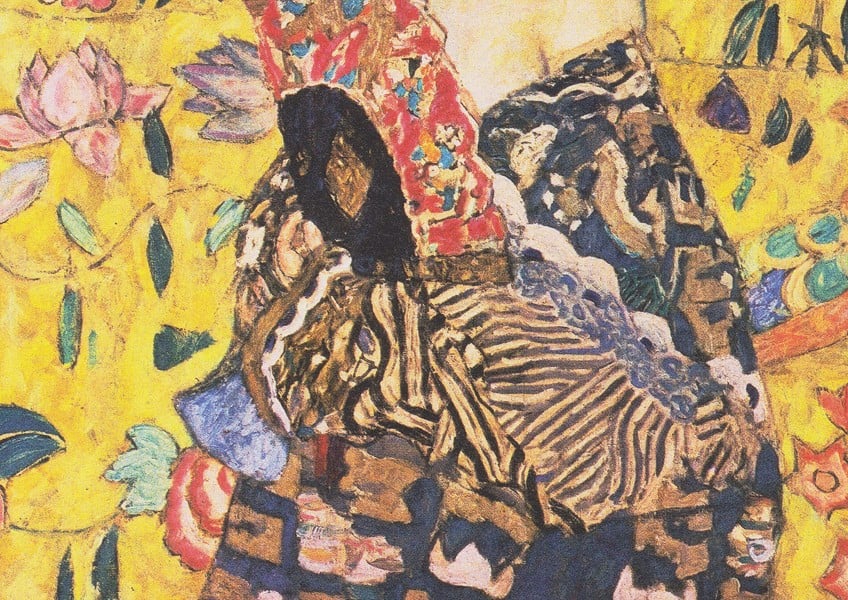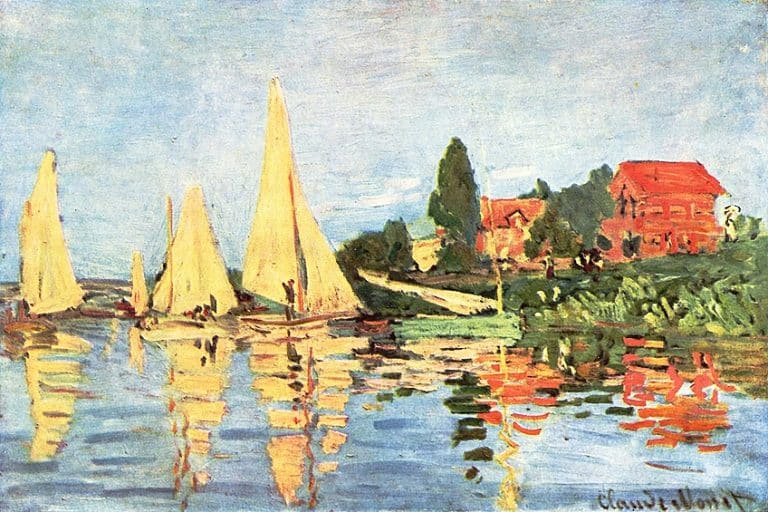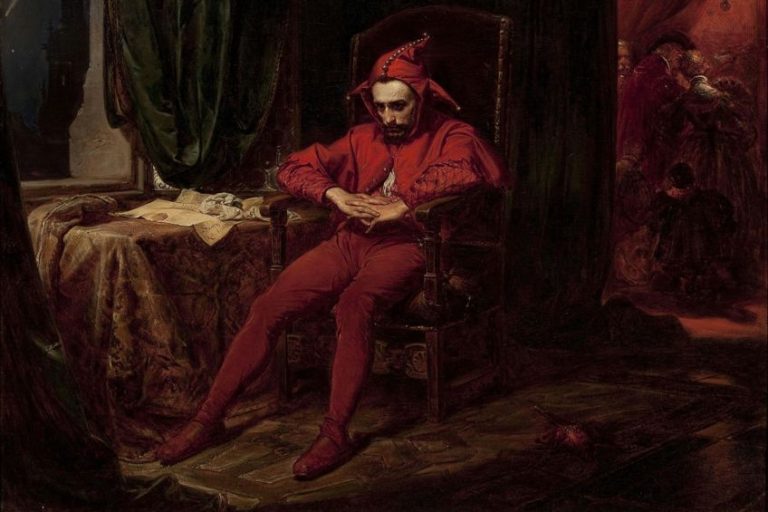“Lady with a Fan” by Gustav Klimt – Klimt’s Late Masterpiece
Lady with a Fan, painted by Gustav Klimt between 1917 and 1918, is a captivating representation of the artist’s signature style, merging sumptuous ornamentation with profound sensuality. This artwork, completed in the final year of Klimt’s life, showcases his mastery of portraiture and his fascination with Asian art motifs. The painting features a richly adorned woman holding a delicate fan, enveloped in a tapestry of intricate patterns and vibrant colors. Klimt’s characteristic use of gold and elaborate decorative elements highlights the opulent and dreamlike quality of the piece, making Lady with a Fan a stunning example of his contribution to the Symbolist movement and his enduring legacy in the world of art.
Key Takeaways
- Lady with a Fan was Gustav Klimt’s final and uncommissioned portrait.
- The painting blends Asian influences with Art Nouveau elements.
- Recently sold for over $108 million, it reflects Klimt’s enduring market influence.
The Artist Behind the Masterpiece
| Artist | Gustav Klimt (1862 – 1918) |
|---|---|
| Date Created | 1917 – 1918 |
| Medium | Oil on canvas |
| Genre | Portrait |
| Period/Movement | Symbolism |
| Dimensions (cm) | 100.2 x 100.2 |
| Series/Versions | N/A |
| Where Is It Housed? | Private collection |
| What It Is Worth | Approximately $105 million (as of 2023) |
Gustav Klimt’s Lady with a Fan stands as a significant work, embodying the essence of his late artistic phase. Painted between 1917 and 1918, it is noted for its vibrant Asian influences and intricate details. The uncommissioned portrait, capturing an unidentified woman, was his final creation and was left on an easel in his studio upon his death in 1918.
Lady with a Fan recently made headlines by becoming the most expensive Klimt painting sold at auction, fetching over $108 million.
The painting highlights Klimt’s fascination with Asian motifs and the Art Nouveau movement, characterized by natural forms and decorative arts. Its bold and sensual portrayal sparked controversy initially but has since been celebrated for its artistic mastery. Today, it stands as a testament to Klimt’s innovation and his unique approach to portraiture.

Lady with a Fan also reflects the broader cultural and market impact of Klimt’s work. Its record-breaking auction price not only underscores the value placed on Klimt’s artistic contributions but also signals a growing appreciation for his unique blend of styles. This masterpiece continues to captivate art enthusiasts and collectors around the world.
Gustav Klimt’s Artistic Prime
Gustav Klimt reached his artistic prime in the late 19th and early 20th centuries. Renowned for his vibrant use of color and intricate patterns, he became a leading name in Symbolist painting. Key works from this period include The Kiss and the Portrait of Adele Bloch-Bauer I.
His innovative techniques and bold compositions set him apart, influencing contemporaries such as Egon Schiele and René Magritte.
Influence of the Vienna Secession Art Movement
Klimt was a founding member of the Vienna Secession in 1897, a movement that sought to break away from traditional academic art. The group embraced new artistic styles and techniques, including Symbolism and Art Nouveau. This movement profoundly impacted Klimt’s work, allowing him to explore more avant-garde themes and incorporate diverse influences, including Asian motifs, as seen in Lady with a Fan.

Klimt’s Portraiture and Lady with a Fan in Context
Klimt’s portraiture skillfully blended realism with decorative abstraction. Lady with a Fan exemplifies this approach, depicting an unidentified woman amidst rich patterns and exotic elements. Found on his easel at the time of his death in 1918, the painting reflects Klimt’s mature style, characterized by opulent textures and a keen focus on the sitter’s visage.
This piece aligns with Klimt’s fascination with the human form and decorative detail, marking a significant entry in his portrait oeuvre.
The Painting and Its Journey
Lady with a Fan by Gustav Klimt is celebrated for its rich artistic detail and fascinating history. The painting’s journey from Klimt’s studio to record-breaking auctions provides insight into its significance and evolving legacy.
Analysis of Lady with a Fan
Lady with a Fan or Dame mit Fächer was painted between 1917 and 1918, during the later years of Klimt’s career. This oil on canvas piece is characterized by its vibrant colors, intricate patterns, and the use of gold leaf, a hallmark of Klimt’s Art Nouveau style. The painting features an unidentified woman holding a delicate fan, surrounded by lush florals and motifs inspired by Japanese art. The composition showcases Klimt’s technical mastery and his ability to blend decorative elegance with psychological depth.

Provenance and Ownership History
The painting was unfinished at Klimt’s death in 1918 and remained in his studio. It was later acquired by Erwin Böhler, a Viennese industrialist and acquaintance of Klimt. The artwork then became part of the collection of Rudolf Leopold, a significant Austrian art collector, and founder of the Leopold Museum in Vienna.
Over the decades, Lady with a Fan transitioned through multiple private hands, illustrating its enduring appeal among collectors.
Record-Breaking Auctions
Lady with a Fan has set multiple auction records, emphasizing its importance in the art market. In recent events, it was sold for £85.3 million ($108.4 million), making it one of the most expensive artworks sold at auction. This record-breaking sale highlights the painting’s lasting allure and significant return on investment.

Previous notable owners include media mogul Oprah Winfrey, who sold the piece to a Hong Kong collector, further underscoring its high-profile provenance. The journey of Lady with a Fan is a rich tapestry of art history, marked by its creation in Klimt’s studio, a legacy of esteemed ownership, and its status in the global art market.
Artistic Elements and Techniques
Lady with a Fan showcases his distinctive style through an intricate use of gold leaf, vibrant colors, and a blend of Asian influences like Chinese motifs and Japonisme. This work also explores themes of symbolism and rebirth.
Use of Gold Leaf and Color
Gustav Klimt is renowned for his use of gold leaf, which gives his works an ethereal quality. In Lady with a Fan, the gold leaf is used subtly but effectively to highlight the intricate details of the woman’s attire and background patterns.
The vivid color palette includes rich greens, deep blues, and bright reds.
These colors contrast beautifully with the gold, creating a mesmerizing visual effect. Klimt’s brushstrokes are deliberate and varied, adding texture and depth to the piece. The distinctive use of gold and vibrant colors makes the painting a quintessential example of his mature style.
Chinese Motifs and Japonisme
Klimt’s admiration for Asian art is evident in Lady with a Fan through the incorporation of Chinese motifs and Japonisme. The woman in the portrait wears a robe adorned with intricate Chinese patterns, including depictions of cranes and phoenixes. Lotus blossoms are another recurring motif, symbolizing purity and enlightenment in both Chinese and Japanese cultures.

Klimt’s fascination with these elements is reflective of the broader Art Nouveau movement, which often borrowed from Asian aesthetics. The influence of Japonisme is seen in the stylized patterns and geometric designs that frame the composition. These elements create a harmonious balance between the figure and background, showcasing Klimt’s skill in blending diverse artistic traditions.
Symbolism and Themes of Rebirth
Lady with a Fan delves into deeper symbolic meanings, particularly themes of rebirth and transformation. The presence of the phoenix, a mythological bird that is reborn from its ashes, suggests themes of renewal and perpetual change. The crane, another symbol present in the painting, is often associated with longevity and good fortune in Asian culture.
These symbols add layers of meaning to the work, inviting viewers to ponder the mysteries of life and renewal.
Klimt’s use of these symbols demonstrates his fascination with the cyclical nature of existence and his ability to convey complex themes through visual art. This makes Lady with a Fan not just a feast for the eyes, but also a thought-provoking piece.
Cultural and Market Impact
Gustav Klimt’s Lady with a Fan has significantly influenced modern art. Its Art Nouveau style and use of gold leaf showcase Klimt’s unique flair. The painting is one of the few privately owned portraits, increasing its allure among art collectors and patrons. Recently, the painting set a new European auction record when it sold for £85.3 million ($108.4 million). This sale confirmed the piece’s status as one of the most valuable works of art ever sold in Europe.
The art market has seen renewed interest in Klimt’s work, with Lady with a Fan becoming a central focus. Its value far exceeded initial estimates, highlighting its cultural and monetary significance.

Exhibition history also plays a role. The painting sparked controversy on its initial display due to its erotic content, but it has since become a celebrated work in museum exhibitions worldwide. Art collectors regard Lady with a Fan as a masterpiece, often competing fiercely in auctions to own such a valuable piece. The astronomical sale price underscores the continued relevance and demand for Klimt’s art.
Lady with a Fan epitomizes Gustav Klimt’s unparalleled ability to blend intricate design with evocative portraiture. This masterpiece, completed in the twilight of his career, encapsulates his deep appreciation for beauty and ornamentation, influenced by both his Viennese surroundings and Japanese art. The painting’s lush textures and vibrant palette offer a glimpse into Klimt’s artistic vision, characterized by a harmonious fusion of form and decoration. Lady with a Fan remains a testament to Klimt’s innovative spirit and enduring influence, capturing the essence of his contribution to early 20th-century art.
Frequently Asked Questions
What Symbolism Is Present in Lady with a Fan by Gustav Klimt?
The painting features motifs of fans and floral patterns, often seen in Klimt’s works. These elements highlight themes of femininity and nature. The use of gold leaf symbolizes luxury and the mystique of the subject.
Can You Explain the Historical Context of Klimt’s Lady with a Fan Painting?
Created during the later Art Nouveau movement between 1917 and 1918, Lady with a Fan was among Klimt’s final works. The painting reflects the style’s emphasis on ornate decoration and natural forms. It was unfinished at the time of Klimt’s death in 1918.
What Are the Distinguishing Features of Klimt’s Lady with a Fan?
The painting is known for its rich, decorative background filled with intricate patterns. It depicts a woman holding a fan, rendered with Klimt’s signature use of gold leaf. The dimensions are 100.2 cm by 100.2 cm, making it a square canvas.
How Does Lady with a Fan Compare to Other Portraits by Gustav Klimt?
Lady with a Fan shares stylistic elements with Klimt’s other portraits, such as The Kiss and Portrait of Adele Bloch-Bauer I. The ornamental background and the depiction of the female form are consistent with his artistic approach. However, the fan motif is unique to this piece.
Isabella studied at the University of Cape Town in South Africa and graduated with a Bachelor of Arts majoring in English Literature & Language and Psychology. Throughout her undergraduate years, she took Art History as an additional subject and absolutely loved it. Building on from her art history knowledge that began in high school, art has always been a particular area of fascination for her. From learning about artworks previously unknown to her, or sharpening her existing understanding of specific works, the ability to continue learning within this interesting sphere excites her greatly.
Her focal points of interest in art history encompass profiling specific artists and art movements, as it is these areas where she is able to really dig deep into the rich narrative of the art world. Additionally, she particularly enjoys exploring the different artistic styles of the 20th century, as well as the important impact that female artists have had on the development of art history.
Learn more about Isabella Meyer and the Art in Context Team.
Cite this Article
Isabella, Meyer, ““Lady with a Fan” by Gustav Klimt – Klimt’s Late Masterpiece.” Art in Context. July 30, 2024. URL: https://artincontext.org/lady-with-a-fan-by-gustav-klimt/
Meyer, I. (2024, 30 July). “Lady with a Fan” by Gustav Klimt – Klimt’s Late Masterpiece. Art in Context. https://artincontext.org/lady-with-a-fan-by-gustav-klimt/
Meyer, Isabella. ““Lady with a Fan” by Gustav Klimt – Klimt’s Late Masterpiece.” Art in Context, July 30, 2024. https://artincontext.org/lady-with-a-fan-by-gustav-klimt/.











